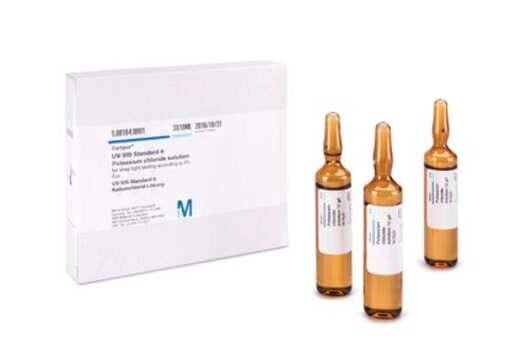1.04372
Hexane
≥99% (GC), suitable for UV/Vis spectroscopy, Uvasol®
Synonym(s):
Hexane, n-Hexane
About This Item
5.2 psi ( 37.7 °C)
~132 mmHg ( 20 °C)
Recommended Products
Product Name
n-Hexane, for spectroscopy Uvasol®
vapor density
~3 (vs air)
Quality Level
vapor pressure
256 mmHg ( 37.7 °C)
5.2 psi ( 37.7 °C)
~132 mmHg ( 20 °C)
Assay
≥99% (GC)
form
liquid
autoignition temp.
453 °F
potency
25000 mg/kg LD50, oral (Rat)
>2000 mg/kg LD50, skin (Rabbit)
expl. lim.
7.7 %
technique(s)
UV/Vis spectroscopy: suitable
impurities
≤0.0002 meq/g Acidity
≤0.0002 meq/g Alkalinity
≤0.005% Water
evapn. residue
≤0.0002%
color
APHA: ≤10
transmittance
195 nm, ≥10%
210 nm, ≥60%
217 nm, ≥80%
225 nm, ≥90%
245 nm, ≥98%
refractive index
n20/D 1.375 (lit.)
kinematic viscosity
0.50 cSt(20 °C)
bp
69 °C (lit.)
mp
−95 °C (lit.)
transition temp
flash point -22 °C
density
0.659 g/mL at 25 °C (lit.)
UV absorption
λ: 195 nm Amax: ≤1.00
λ: 210 nm Amax: ≤0.22
λ: 217 nm Amax: ≤0.10
λ: 225 nm Amax: ≤0.05
λ: 245 nm Amax: ≤0.01
storage temp.
2-30°C
SMILES string
CCCCCC
InChI
1S/C6H14/c1-3-5-6-4-2/h3-6H2,1-2H3
InChI key
VLKZOEOYAKHREP-UHFFFAOYSA-N
Looking for similar products? Visit Product Comparison Guide
General description
Application
- Enhancing the selectivity for light olefins through catalytic cracking of n-hexane by phosphorus doping on lanthanum-modified ZSM-5.: This study investigates the use of n-Hexane in catalytic cracking processes, emphasizing its role in improving selectivity for light olefins through advanced catalytic techniques (Ali et al., 2024).
- Facile synthesis of iron nanoparticles from Camellia Sinensis leaves catalysed for biodiesel synthesis from Azolla filiculoides.: This research utilizes n-Hexane as a solvent in the synthesis of iron nanoparticles, highlighting its application in green chemistry and nanoparticle synthesis for biodiesel production (Sundararaman et al., 2024).
- Rapid purification and scale-up of tilianin using counter-current chromatography with rectangular horizontal tubing.: The study employs n-Hexane in counter-current chromatography for the purification of tilianin, demonstrating its efficiency in natural product isolation and analytical chemistry (Zhang et al., 2024).
- Phytochemicals, Antioxidant, and Antidiabetic Effects of Ranunculus hirtellus Aerial Parts and Roots: Methanol and Aqueous Extracts.: This research uses n-Hexane in the extraction and analysis of phytochemicals, underlining its importance in the study of antioxidant and antidiabetic properties of plant extracts (Ishtiaq et al., 2024).
- Exploration of reducing and stabilizing phytoconstituents in Arisaema dracontium extract for the effective synthesis of Silver nanoparticles and evaluation of their antibacterial and toxicological properties.: The study highlights the use of n-Hexane in the synthesis of silver nanoparticles, focusing on its role in nanoparticle stabilization and antibacterial activity assessment (Khattak et al., 2024).
Analysis Note
Evaporation residue: ≤ 0.0002 %
Water: ≤ 0.005 %
Color: ≤ 10 Hazen
Acidity: ≤ 0.0002 meq/g
Alkalinity: ≤ 0.0002 meq/g
Fluorescence (as quinine at 254 nm): ≤ 1.0 ppb
Fluorescence (as quinine at 365 nm): ≤ 1.0 ppb
Transmission (at 195 nm): ≥ 10 %
Transmission (at 210 nm): ≥ 60 %
Transmission (at 217 nm): ≥ 80 %
Transmission (at 225 nm): ≥ 90 %
Transmission (from 245 nm): ≥ 98 %
Absorbance (at 195 nm): ≤ 1.00
Absorbance (at 210 nm): ≤ 0.22
Absorbance (at 217 nm): ≤ 0.10
Absorbance (at 225 nm): ≤ 0.05
Absorbance (from 245 nm): ≤ 0.01
Meet the requirements of "Specific use spectroscopy" according Reag. Ph Eur
Other Notes
Legal Information
related product
Signal Word
Danger
Hazard Statements
Precautionary Statements
Hazard Classifications
Aquatic Chronic 2 - Asp. Tox. 1 - Flam. Liq. 2 - Repr. 2 - Skin Irrit. 2 - STOT RE 2 Inhalation - STOT SE 3
Target Organs
Central nervous system, Nervous system
Storage Class Code
3 - Flammable liquids
WGK
WGK 3
Flash Point(F)
-7.6 °F
Flash Point(C)
-22 °C
Certificates of Analysis (COA)
Search for Certificates of Analysis (COA) by entering the products Lot/Batch Number. Lot and Batch Numbers can be found on a product’s label following the words ‘Lot’ or ‘Batch’.
Already Own This Product?
Find documentation for the products that you have recently purchased in the Document Library.
Customers Also Viewed
Our team of scientists has experience in all areas of research including Life Science, Material Science, Chemical Synthesis, Chromatography, Analytical and many others.
Contact Technical Service









